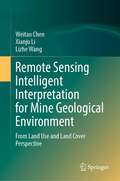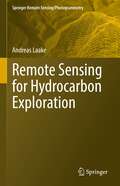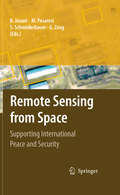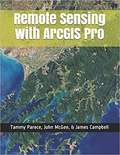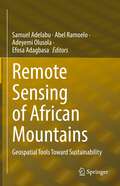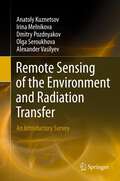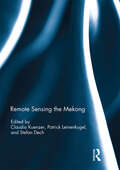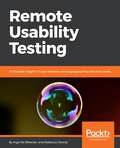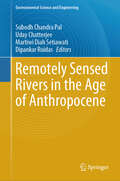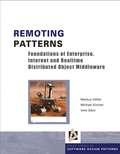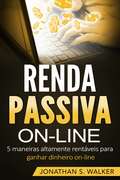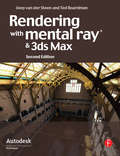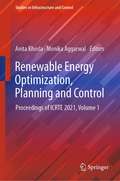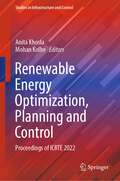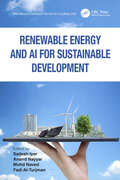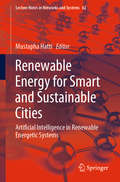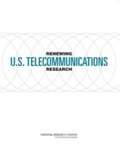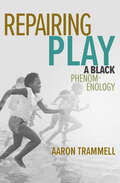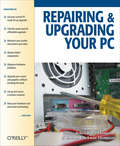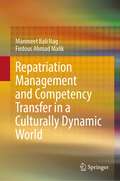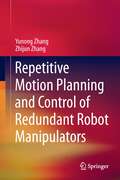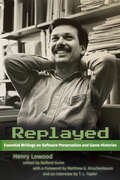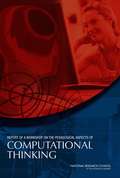- Table View
- List View
Remote Sensing Intelligent Interpretation for Mine Geological Environment: From Land Use and Land Cover Perspective
by Lizhe Wang Weitao Chen Xianju LiThis book examines the theory and methods of remote sensing intelligent interpretation based on deep learning. Based on geological and environmental effects on mines, this book constructs a set of systematic mine remote sensing datasets focusing on the multi-level task with the system of “target detection→scene classification→semantic segmentation." Taking China’s Hubei Province as an example, this book focuses on the following four aspects: 1. Development of a multiscale remote sensing dataset of the mining area, including mine target remote sensing dataset, mine (including non-mine areas) remote sensing scene dataset, and semantic segmentation remote sensing dataset of mining land cover. The three datasets are the basis of intelligent interpretation based on deep learning. 2. Research on mine target remote sensing detection method based on deep learning. 3. Research on remote sensing scene classification method of mine and non-mine areas based on deep learning. 4. Research on the fine-scale classification method of mining land cover based on semantic segmentation.The book is a valuable reference both for scholars, practitioners and as well as graduate students who are interested in mining environment research.
Remote Sensing for Hydrocarbon Exploration (Springer Remote Sensing/Photogrammetry)
by Andreas LaakeThis book provides insights into the benefits of using remote sensing data from a geoscientist's perspective, by integrating the data with the understanding of Earth's surface and subsurface. In 3 sections, the book takes a detailed look at what data explorationists use when they explore for hydrocarbon resources, assess different terrain types for planning and hazards and extract present-day geologic analogs for subsurface geologic settings. The book presents the usage of remote sensing data in exploration in a structured way by detecting individual geologic features as building blocks for complex geologic systems. This concept enables readers to build their own workflows for the assessment of complex geologic systems using various combinations of remote sensing data. Section 1 introduces readers to the foundations of remote sensing for exploration, covers various methods of image processing and studies different digital elevation and bathymetry models. Section 2 presents the concept of geomorphology as a means to integrate surface and subsurface data. Different aspects of rendering in 2D and 3D are explained and used for the interpretation and extraction of geologic features that are used in exploration.Section 3 addresses remote sensing for hydrocarbon exploration in detail, from geophysical data acquisition to development and infrastructure planning. The organization of this chapter follows an exploration workflow from regional to local modeling studying basin and petroleum system modeling as well as logistics planning of seismic surveys and near-surface modeling. Aspects of field development and infrastructure planning comprise multi-temporal and dynamic modeling. The section closes with a structured approach to extracting geologic analogs from interpreted remote sensing data.The book will be of interest to professionals and students working in exploration for hydrocarbons and water resources, as well as geoscientists and engineers using remote sensing for infrastructure planning, hazard assessment and dynamic environmental studies.
Remote Sensing from Space
by Gunter Zeug Martino Pesaresi Stefan Schneiderbauer Bhupendra JasaniThis volume provides the reader with an overview of the state-of-the-art Earth Observation (EO) related research that deals with national and international security. An interdisciplinary approach was adopted in this book in order to provide the reader with a broad understanding on the uses of remote sensing technologies. The book therefore comprises management aspects (issues and priorities of security research, crisis response), applied methodologies and process chains (treaty monitoring, estimation of population densities and characteristics, border permeability models, damage assessment) and the latest developments in generic tools (feature recognition, change detection and visualization). Moreover, issues of data sharing and standards, as well as new approaches to training security relevant techniques, are addressed. The contributing authors are leading researchers and experts from private companies, national research institutions and international organizations, all of whom were brought together under the aegis of the European research project GMOSS (Global Monitoring for Security and Stability). This book is tailored for the scientific community that deals with the application of EO data, as well as project managers and decision makers working in the field of security having an interest in technical solutions. The integrative use of many figures and sample images are ideal in enabling the non-technical reader to grasp quickly the modern technologies that are being researched in the area of civil security.
Remote Sensing in ArcGIS® Pro
by Tammy E. Parece James B. Campbell John A. McGeeRemotely sensed images are widely available and have countless potential applications. In the past, analyzing these images required specialized software. Esri’s ArcGIS Pro software includes tools that can be used by novice and experienced analysts. In this manual, we provide a series of easy-to-understand, step-by-step tutorials to guide you through image analysis processes. By completing this series of tutorials, you will be able to: •Manipulate data in ArcGIS Pro •Obtain and display Landsat data •Display image data from Landsat or other remote sensing platforms (including Sentinel and sUAS) •Enhance and analyze remotely sensed imagery.Videos available through the Virginia Geospatial Extension Program’s YouTube Channel can be used as additional resources to accompany this manual.
Remote Sensing of African Mountains: Geospatial Tools Toward Sustainability
by Samuel Adelabu Abel Ramoelo Adeyemi Olusola Efosa AdagbasaThis edited volume focuses on the use of remote sensing techniques to assess and monitor mountainous ecosystems in Africa, with a focus on tracking changes related to climate change and human activity. The book is timely, as the interaction of mountain environmental dynamics with conservation and sustainability is an under-researched issue. The chapters in this volume use remotely sensed data to study a variety of topics related to mountains and their ecosystems, including but not limited to vegetation, energy systems, environmental hazards, ecosystem services, diseases, climatic shifts, geological formations and geomorphological dynamics. The ability to monitor, assess and analyze mountainous regions is aided by the availability of remote sensing products such as optical and microwave sensors and low-cost unmanned aerial vehicles (UAVs). The works presented here push the frontier of knowledge on mountain studies and will help shape local, national and global assessments and policies, including efforts toward the achievement of the African Agenda 2063. The book will be of interest to researchers and students in remote sensing, geography, ecology and sustainability, as well as to government organizations and conservation specialists.
Remote Sensing of Urban Green Space
by Qingyan MengThis book presents a systematic study of urban green space remote sensing from multi-dimensional and multi-scale technologies. On the basis of introducing the connotation, science and application value of urban green space, this book focuses on the two-dimensional and three-dimensional information extraction technology of urban vegetation, two-dimensional and three-dimensional measurement technology of urban green space and multi-scale perception technology and discusses the remote sensing evaluation method of urban green space. By exploring the technical advantages of ‘satellite remote sensing + aerial remote sensing + near-ground remote sensing’, urban green space remote sensing promotes the development of urban vegetation research from two-dimensional to three-dimensional observation, so that the quantity, quality and human perception of urban vegetation can be measured. In each chapter, an individual technology/method is introduced, and several cases are cited to demonstrate its practical application. This book offers a valuable reference guide for practitioners in urban planning, landscape greening, environmental protection and urban management, as well as teachers and graduate students engaged in urban remote sensing research.
Remote Sensing of the Environment and Radiation Transfer
by Alexander Vasilyev Dmitry Pozdnyakov Irina Melnikova Olga Seroukhova Anatoly KuznetsovThe interaction of the solar and heat radiation with the atmosphere and surface is the subject of the book. It is useful also for wide circle scientists involved in environmental studies. The book contains the description of 17 computer studying programs supporting different topics of courses. It includes only the base ground for comprehension of key topics and provides the accomplishment of practical works with using specially elaborated computer programs. Themes of practical works reflect main sections of mentioned courses of lectures. The packet of computer programs is added for solution of direct and inverse problems. It promotes deep and reliable comprehension of corresponding topics by students. All described approaches and computer programs are valuable resources for solving radiative transfer problems and they could be used by students for courses and diploma studies concerned atmospheric optics.
Remote Sensing the Mekong
by Claudia Kuenzer Stefan Dech Patrick LeinenkugelThe Mekong Basin in Southeast Asia is one of the largest international river basins in the world. Its abundant natural resources are shared by six riparian countries and provide the basis for the livelihoods of more than 75 million people. However, ongoing socio-economic growth and related anthropogenic interventions impact the region’s ecosystems, and there is an urgent need for the monitoring of the basin's land surface dynamics. Remote sensing has evolved as a key tool for this task, allowing for up-to-date analyses and regular monitoring of environmental dynamics beyond physical or political boundaries and at various temporal and spatial scales. This book serves as a forum for remote-sensing scientists with an interest in the Mekong River Basin to present their recent basin-related works as well as applied case studies of the region. A broad range of sensors from high to medium resolution, and from multispectral to SAR systems, are applied, covering topics such as land cover/land use classification and comparison, time series analyses of climate variables, vegetation structure and vegetation productivity, as well as studies on flood mapping or water turbidity monitoring. This book was originally published as a special issue of the International Journal of Remote Sensing.
Remote Usability Testing: Actionable insights in user behavior across geographies and time zones
by Inge De Bleecker Rebecca OkorojiGain actionable insights from qualitative remote studies to improve user experienceKey FeaturesUnderstand the different usability testing methodologies and their strengths and weaknessesMaster the execution of remote studiesLearn how to analyze and present study resultsBook DescriptionUsability testing is a subdiscipline of User Experience. Its goal is to ensure that a given product is easy to use and the user's experience with the product is intuitive and satisfying. Usability studies are conducted with study participants who are representative of the target users to gather feedback on a user interface. The feedback is then used to refine and improve the user interface.Remote studies involve fewer logistics, allow participation regardless of location and are quicker and cheaper to execute compared to in person studies, while delivering valuable insights. The users are not inhibited by being in a new environment under observation; they can act naturally in their familiar environment. Remote unmoderated studies additionally have the advantage of being independent of time zones.This book will teach you how to conduct qualitative remote usability studies, in particular remote moderated and unmoderated studies. Each chapter provides actionable tips on how to use each methodology and how to compensate for the specific nature of each methodology. The book also provides material to help with planning and executing each study type.What you will learnChoose the most suitable remote study methodologyEstablish a clear goal for the study Plan the study execution Understand recruitment logistics, expectations and compensationSet up and moderate remote studies Write good tasks and questions for each methodology Analyze and document the study results Deliver results that align with the goal for the studyWho this book is forThis book is for user experience (UX) professionals familiar with traditional in-person usability testing methodologies, or for UX designers with no prior exposure to user research and usability testing. Customer experience professionals or product managers who want to understand remote usability testing will also find this book useful. No knowledge of remote usability testing is needed.
Remote Work Technology: Keeping Your Small Business Thriving From Anywhere
by Henry KurkowskiYour small business survival guide for the remote work environment In Remote Work Technology: Keeping Your Small Business Thriving From Anywhere, experienced SaaS and telecommunications entrepreneur Henry Kurkowski delivers a step-by-step walkthrough for using SaaS technology and communication apps to power your small business from anywhere on the planet. You'll learn how to capitalize on the ability to hire a geographically distributed workforce and excel at serving clients at a distance. You'll also discover why and how you need to alter your approach to management and spot the common pitfalls that litter the way to a truly distributed business. This important book includes: Valuable case studies of businesses that embraced the reality of remote working during and after the COVID-19 pandemic and cautionary tales of unexpected challenges that arose during the transition. Discussions of how to incorporate remote workers into efficient workflows to increase your business' productivity Explorations of how to support your employees when you can't just pop into their office Perfect for small business founders, owners, and managers, Remote Work Technology is also a must-read guide for independent contractors who work directly with small businesses and entrepreneurs.
Remotely Sensed Rivers in the Age of Anthropocene (Environmental Science and Engineering)
by Uday Chatterjee Subodh Chandra Pal Martiwi Diah Setiawati Dipankar RuidasThis book offers a geospatial technology approach to data mining techniques, data analysis, modeling, risk assessment, and visualization, as well as management strategies in many elements of river basin risks. This book investigates cutting-edge techniques based on open source software and R statistical programming Google Earth Engine and modeling in modern artificial intelligence techniques, with a particular emphasis on recent trends in data mining techniques and robust modeling in river basin management. It includes significant issues such as geomorphological hazards, climate change, catastrophic natural disasters, meteorological and agricultural drought monitoring, landslides or mudslides (mudflow), floods and flash floods, soil erosion, and land degradation. This book's contents are of interest to earth and environmental scientists, professionals, and policymakers. The book examines spatial modeling, risk evaluation of a drainage basin in the domain of environmental and social issues, management, and associated research. Due to poorly understood climate change and unclear man-made activity, there are several problems and uncertainties in studying earth's environmental circumstances, making it exceedingly difficult to analyze and make knowledgeable judgments. Many difficulties, on the other hand, are caused by mismanagement of present and future land, water, and forestry resources. It is also critical to use new technology and methods to improve and reinforce environmental protection. The link between the three devices, namely remote sensing (RS), GIS, and the R programming interface, is acknowledged in this respect. Land conservation measures, soil and water quality control, and new rules should all rely on correct measurements and predictions, and three technologies (RS, GIS, and R) and open access quantitative forecasting methodologies help with climate change and better management regulations. Nonetheless, this book serves as a feasible framework for studying current breakthroughs in geospatial artificial intelligence technologies and their relevance to the planet's environmental and socioeconomic concerns in a single volume.
Remoting Patterns
by Michael Kircher Markus Völter Uwe ZdunRemoting offers developers many ways to customize the communications process, for efficiency, security, performance and power, and allows seamless integration of components running on several computers into a single application. This book exposes the full power of remoting to developers working in mixed platform environments in a way that will ensure they have a deep understanding of what remoting is capable of, and how they can make it work the way they want.
Renda passiva
by Jonathan S. Walker Beatriz AntunesAprenda os segredos para fazer renda passiva online hoje e começar a ganhar dinheiro que irá trabalhar para você! Você está cansado de trabalhar como um cachorro, correndo todos os dias como todo mundo lá fora? Trocando seu tempo por dinheiro dia após dia, sacrificando tempo de qualidade com amigos e família e nunca tendo o suficiente para gastar com seus entes queridos? E se eu dissesse agora mesmo que existe uma maneira de você construir um Império de Renda Passiva online sem ter que largar seu emprego? Você aceitaria isso? Renda Passiva Online é a sua melhor solução para isso. Para ser esse cara que todo mundo tem inveja, você precisará começar a construir um negócio de renda passiva online hoje. Leva tempo para desenvolver um negócio a partir do zero e este livro fornecerá as etapas exatas que você precisará seguir para iniciar essa jornada. Neste livro você vai aprender: 5 fontes rentáveis para construir fluxos de renda passiva online Estratégias específicas sobre como crescer os negócios Crie blogs geradores rentáveis e de alta renda Construindo um império de negócios e vendendo com a FBA Como configurar um site para inscritos Como ganhar dinheiro vendendo Ebooks na Amazon Kindle Store Como configurar um canal rentável no Youtube Resultados ca construção de Renda Passiva Online: Ser capaz de viajar pelo mundo Realizar seus sonhos Ter segurança financeira Seja financeiramente livre de estresse Compre qualquer coisa que você quiser a qualquer momento Você vai obter todas essas estratégias incríveis detalhadas perfeitamente para você passo a passo. Com todo esse conhecimento ao seu alcance, você daria um salto de fé e se tornaria alguém que está financeiramente livre e que tem renda passiva em seus bolsos todos os dias? Alguém que é aposentado antes dos 40 anos e tem a liberdade de viver a vida ao máximo com seus entes quer
Rendering with mental ray and 3ds Max
by Ted Boardman Joep van der SteenCreate stunning renders of your 3ds Max models in mental ray with this concise guide. Learn all of the essential concepts such as indirect illumination, materials, render options, shaders, and lighting. Rendering with mental ray and 3ds Max, Second Edition is now revised to cover Autodesk Revit and special effects. The companion website includes all of the necessary project files from inside the book.
Renewable Energy Optimization, Planning and Control: Proceedings of ICRTE 2021, Volume 1 (Studies in Infrastructure and Control)
by Anita Khosla Monika AggarwalThis book gathers selected high-quality research papers presented at International Conference on Renewable Technologies in Engineering (ICRTE 2021) organized by Manav Rachna International Institute of Research & Studies, Faridabad, Haryana, India, during 15–16 April 2021. The book includes conference papers on the theme “Computational Techniques for Renewable Energy Optimization”, which aims to bring together leading academic scientists, researchers and research scholars to exchange and share their experiences and research results on all aspects of renewable energy integration, planning, control and optimization. It also provides a premier interdisciplinary platform for researchers, practitioners and educators to present and discuss the most recent innovations, trends and concerns as well as practical challenges encountered and solutions adopted in the fields of renewable energy and resources.
Renewable Energy Optimization, Planning and Control: Proceedings of ICRTE 2022 (Studies in Infrastructure and Control)
by Mohan Kolhe Anita KhoslaThis book gathers selected high-quality research papers presented at International Conference on Renewable Technologies in Engineering (ICRTE 2022) organized by Manav Rachna International Institute of Research & Studies, Faridabad, Haryana, India, during October 7–8, 2022. The book includes conference papers on the theme ‘Computational Techniques for Renewable Energy Optimization,’ which aims to bring together leading academic scientists, researchers, and research scholars to exchange and share their experiences and research results on all aspects of renewable energy integration, planning, control, and optimization. It also provides a premier interdisciplinary platform for researchers, practitioners, and educators to present and discuss the most recent innovations, trends, and concerns as well as practical challenges encountered and solutions adopted in the fields of renewable energy and resources.
Renewable Energy and AI for Sustainable Development (Innovations in Intelligent Internet of Everything (IoE))
by Fadi Al-Turjman Anand Nayyar Mohd Naved Sailesh IyerElectronic device usage has increased considerably in the past two decades. System configurations are continuously requiring upgrades; existing systems often become obsolete in a matter of 2–3 years. Green computing is the complete effective management of design, manufacture, use, and disposal, involving as little environmental impact as possible. This book intends to explore new and innovative ways of conserving energy, effective e-waste management, and renewable energy sources to harness and nurture a sustainable eco-friendly environment. This book: • Highlights innovative principles and practices using effective e-waste management and disposal • Explores artificial intelligence based sustainable models • Discovers alternative sources and mechanisms for minimizing environmental hazards • Highlights successful case studies in alternative sources of energy • Presents solid illustrations, mathematical equations, as well as practical in-the-field applications • Serves as a one-stop reference guide to stakeholders in the domain of green computing, e-waste management, renewable energy alternatives, green transformational leadership including theory concepts, practice and case studies • Explores cutting-edge technologies like internet of energy and artificial intelligence, especially the role of machine learning and deep learning in renewable energy and creating a sustainable ecosystem • Explores futuristic trends in renewable energy This book aims to address the increasing interest in reducing the environmental impact of energy as well as its further development and will act as a useful reference for engineers, architects, and technicians interested in and working with energy systems; scientists and engineers in developing countries; industries, manufacturers, inventors, universities, researchers, and interested consultants to explain the foundation to advanced concepts and research trends in the domain of renewable energy and sustainable computing. The content coverage of the book is organized in the form of 11 clear and thorough chapters providing a comprehensive view of the global renewable energy scenario, as well as how science and technology can play a vital role in renewable energy.
Renewable Energy for Smart and Sustainable Cities: Artificial Intelligence in Renewable Energetic Systems (Lecture Notes in Networks and Systems #62)
by Mustapha HattiThis book features cutting-edge research presented at the second international conference on Artificial Intelligence in Renewable Energetic Systems, IC-AIRES2018, held on 24–26 November 2018, at the High School of Commerce, ESC-Koléa in Tipaza, Algeria. Today, the fundamental challenge of integrating renewable energies into the design of smart cities is more relevant than ever. While based on the advent of big data and the use of information and communication technologies, smart cities must now respond to cross-cutting issues involving urban development, energy and environmental constraints; further, these cities must also explore how they can integrate more sustainable energies. Sustainable energies are a major determinant of smart cities’ longevity. From an environmental and technological standpoint, these energies offer an optimal power supply to the electric network while creating significantly less pollution. This requires flexibility, i.e., the availability of supply and demand. The end goal of any smart city is to improve the quality of life for all citizens (both in the city and in the countryside) in a way that is sustainable and respectful of the environment. This book encourages the reader to engage in the preservation of our environment, every moment, every day, so as to help build a clean and healthy future, and to think of the future generations who will one day inherit our planet. Further, it equips those whose work involves energy systems and those engaged in modelling artificial intelligence to combine their expertise for the benefit of the scientific community and humanity as a whole.
Renewing U.s. Telecommunications Research
by National Research Council of the National AcademiesThe modern telecommunications infrastructure—made possible by research performed over the last several decades—is an essential element of the U.S. economy. The U.S. position as a leader in telecommunications technology, however, is at risk because of the recent decline in domestic support of long-term, fundamental telecommunications research. To help understand this challenge, the National Science Foundation asked the NRC to assess the state of telecommunications research in the United States and recommend ways to halt the research decline. This report provides an examination of telecommunications research support levels, focus, and time horizon in industry, an assessment of university telecommunications research, and the implications of these findings on the health of the sector. Finally, it presents recommendations for enhancing U.S. telecommunications’ research efforts.
Repairing Play: A Black Phenomenology (Playful Thinking)
by Aaron TrammellA provocative study that reconsiders our notion of play—and how its deceptively wholesome image has harmed and erased people of color.Contemporary theorists present play as something wholly constructive and positive. But this broken definition is drawn from a White European philosophical tradition that ignores the fact that play can, and often does, hurt. In fact, this narrow understanding of play has been complicit in the systemic erasure of Black, Indigenous, and People of Color (BIPOC) from the domain of leisure. In this book, Aaron Trammell proposes a corrective: a radical reconsideration of play that expands its definition to include BIPOC suffering, subjugation, and taboo topics such as torture. As he challenges and decolonizes White European thought, Trammell maps possible ways to reconcile existing theories with the fact that play is often hurtful and toxic.Trammell upends current notions by exploring play&’s function as a tool in the subjugation of BIPOC. As he shows, the phenomenology of play is a power relationship. Even in innocent play, human beings subtly discipline each other to remain within unspoken rules. Going further, Trammell departs from mainstream theory to insist that torture can be play. Approaching it as such reveals play&’s role in subjugating people in general and renders visible the long-ignored experiences of BIPOC. Such an inclusive definition of play becomes a form of intellectual reparation, correcting the notion that play must give pleasure while also recasting play in a form that focuses on the deep, painful, and sometimes traumatic depths of living.
Repairing and Upgrading Your PC
by Robert Bruce Thompson Barbara Fritchman ThompsonMost computer users think that fiddling with the insides of their PC is taboo. They fear that by removing the screws that hold the case on, they're crossing into forbidden territory. And even for those who know they can open the box and fix or upgrade their PC, analysis paralysis often stops them in their tracks: Which upgrades offer the best bang for the buck? How do you pinpoint the faulty component that's making your system freeze? What about compatibility issues?Get ready to get unstuck and get your PC running fast and running right. Repairing and Upgrading Your PC delivers start-to-finish instructions, simple enough for even the most inexperienced PC owner, for troubleshooting, repairing, and upgrading your computer. Written by hardware experts Robert Bruce Thompson and Barbara Fritchman Thompson, this book covers it all: how to troubleshoot a troublesome PC, how to identify which components make sense for an upgrade, and how to tear it all down and put it back together. This book shows how to repair and upgrade all of your PC's essential components:Motherboard, CPU, and Memory. Choose the optimal match of these core components to keep your PC running at top speedHard Drive, Optical Drive, and Removable StorageGive your computer what it needs for long-term and short-term storageAudio and Video. Enhance your computing experience with the right sound and graphics devices for your needsInput Devices. Pick the best keyboard and mouse to keep your hands happy and healthyNetworking. Set up secure wireless networking to keep the bits flowing between your computers and the outside worldCases and Power Supplies. Keep everything running cool and reliablyWith its straightforward language, clear instructions, and extensive illustrations, this book makes it a breeze for PC owners of any skill level to work on their computer.
Repatriation Management and Competency Transfer in a Culturally Dynamic World
by Firdous Ahmad Malik Manmeet Bali NagThis book examines the relevance of global strategic perspective, as international competition continues to intensify & gain momentum, and management of human resource remains a challenge in contemporary corporate scenario. As global business strategy requires globally competent people and implementation of global human resource systems, therefore the need to harness the multi-faceted dimensions of corporate employees is elaborated upon. This book explores cross cultural movement & interactions in International human resource management, where the theme of cross-cultural reentry remains largely neglected and underestimated in the sojourner’s transition trajectory. This book takes into account the available empirical investigations pointing to substantial concerns, affecting the psychological wellbeing, social readjustment and cultural identity of the returning individuals. This book examines the significance of re-entry as an issue of highest priority to both sojourning individuals as well as people managing the reentry transitions of travelers. In light of the unfolding knowledge revolution, the book explores the context of corporate India offering high knowledge density and rich demographic dividend. The need for companies, to harness the knowledge capital and accelerate Indians in the knowledge revolution is examined. Various factors that can influence the repatriation of an individual when back in the home country, and the challenges faced in repatriation at the individual-, team-, organizational-, and country-levels, is explored & analyzed. This book focuses on eliminating overall wastage and losses in Repatriation process, from an organizational point of view.The purview of this book encompasses the interface of Anticipatory Adjustment, Competency Transfer, Effective Repatriation and Reverse Culture Shock with Repatriates’ Adjustment, back home, and empirically analyzes the precursors and effects of the said paradigms in optimization of Repatriate talent from an organizational perspective. The purpose is to analyze the antecedents of repatriate adjustment in the mentioned context and to subsequently deliberate upon the acquired results to arrive at feasible and relevant conclusions. Optimization of Repatriate talent, and Repatriation Management from International Human Resource Management (IHRM) perspective, deserves a cross-disciplinary study of precursors effecting Repatriation Adjustment, with focus on the dimension of Indian Repatriate acculturation.
Repetitive Motion Planning and Control of Redundant Robot Manipulators
by Zhijun Zhang Yunong ZhangRepetitive Motion Planning and Control of Redundant Robot Manipulators presents four typical motion planning schemes based on optimization techniques, including the fundamental RMP scheme and its extensions. These schemes are unified as quadratic programs (QPs), which are solved by neural networks or numerical algorithms. The RMP schemes are demonstrated effectively by the simulation results based on various robotic models; the experiments applying the fundamental RMP scheme to a physical robot manipulator are also presented. As the schemes and the corresponding solvers presented in the book have solved the non-repetitive motion problems existing in redundant robot manipulators, it is of particular use in applying theoretical research based on the quadratic program for redundant robot manipulators in industrial situations. This book will be a valuable reference work for engineers, researchers, advanced undergraduate and graduate students in robotics fields. Yunong Zhang is a professor at The School of Information Science and Technology, Sun Yat-sen University, Guangzhou, China; Zhijun Zhang is a research fellow working at the same institute.
Replayed: Essential Writings on Software Preservation and Game Histories
by Henry LowoodA leading voice in technology studies shares a collection of essential essays on the preservation of software and history of games.Since the early 2000s, Henry E. Lowood has led or had a key role in numerous initiatives devoted to the preservation and documentation of virtual worlds, digital games, and interactive simulations, establishing himself as a major scholar in the field of game studies. His voluminous writings have tackled subject matter spanning the history of game design and development, military simulation, table-top games, machinima, e-sports, wargaming, and historical software archives and collection development. Replayed consolidates Lowood's far-flung and significant publications on these subjects into a single volume. Lowood offers important historical contexts for digital and analog game objects and their implications for both documentation and preservation. Replayed is divided into three sections focused on archives, documentation, and the preservation of historical software, game histories and historiography, and future directions. The volume includes two previously unpublished essays, along with Lowood's reflective section introductions that provide a contemporary take on his previously published works. Rounding out the book are a foreword by Matthew G. Kirschenbaum detailing Lowood's sustained commitment to games, an introduction by editor Raiford Guins sharing Lowood's scholarly and curatorial pursuits, and an extensive interview with Lowood on his personal and professional background conducted by T. L. Taylor. For those interested in the history of technology, game studies, libraries, archives, and museums, Replayed presents the opportunity to read Lowood's works—writing that remains timely, skillfully executed, and rigorously researched—as a major project chronicling the history of games and forecasting the opportunities and challenges faced by future game historians.
Report of a Workshop of Pedagogical Aspects of Computational Thinking
by The National Academy of SciencesIn 2008, the Computer and Information Science and Engineering Directorate of the National Science Foundation asked the National Research Council (NRC) to conduct two workshops to explore the nature of computational thinking and its cognitive and educational implications. The first workshop focused on the scope and nature of computational thinking and on articulating what "computational thinking for everyone" might mean. A report of that workshop was released in January 2010. Drawing in part on the proceedings of that workshop, Report of a Workshop of Pedagogical Aspects of Computational Thinking, summarizes the second workshop, which was held February 4-5, 2010, in Washington, D. C. , and focuses on pedagogical considerations for computational thinking. This workshop was structured to gather pedagogical inputs and insights from educators who have addressed computational thinking in their work with K-12 teachers and students. It illuminates different approaches to computational thinking and explores lessons learned and best practices. Individuals with a broad range of perspectives contributed to this report. Since the workshop was not intended to result in a consensus regarding the scope and nature of computational thinking, Report of a Workshop of Pedagogical Aspects of Computational Thinking does not contain findings or recommendations.
